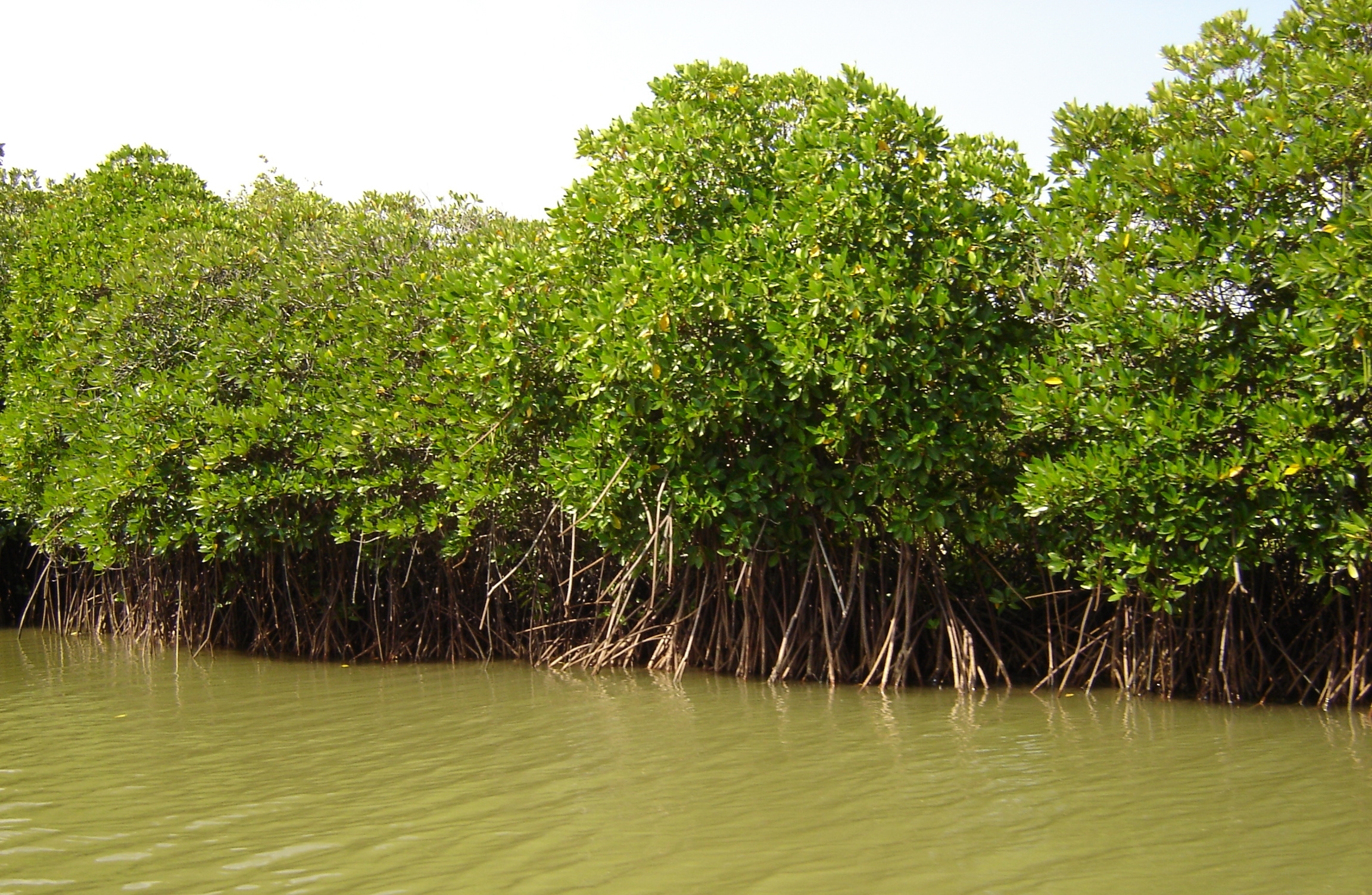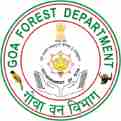MANGROVES IN GOA
Goa houses 16 mangrove species and it has one of the best mangrove forests in the country. Chorao Island in Mandovi river is one of the best mangrove forests and houses most of the species found in Goa..


Species wise description of mangroves found in Goa
1. Rhizophora mucronata:
It is a moderate sized tree, much branched, very rough bark, leaves elliptic, broad, opposite, pale beneath with black dots, flowers yellowish white, four petals, radicle slender, elongated, 15 to 40 cms. long, flowering & fruiting takes place in between December to Mid June. Locally known as Kandal, it is available in plenty in the high salinity areas in all the estuaries.
2. Rhizophora apiculata:
It is a moderate sized much branched tree with rough bark, leaves elliptic, lanceolate, dark green above, base tapering, pink petioled, clustered towards end of branches, infloroscence 3-4 times forked, 4-8 flowered, flowers white, radicle thick, short and cylindrical, upto 30 cms. in length. Flowering and fruiting takes place in between December to May. It is seen mainly in between R. mucronata trees, which is dominant species. The species is found occasionally here and there and its total occurrence is quite less in Goa.
3. Bruguiera gymnorrhiza:
It is a straight stemmed, buttressed tall tree, upto 30m. in height, dark coloured, fissured bark, leaves elliptic, pointed, pale beneath, crowded at branchlet end, flowers solitary, petals bifid with hairs at the base, calyx red to bright red, radicle 15-20 cms. long, faintly ribbed, alike ladyfinger. Flowering and fruiting takes place in between November to April. It is found in low salinity areas and can be seen in the interior areas of the State. The tree has a conical shape and is seen mainly in Zuari & Chapora rivers.
4. Bruguiera cylindrica:
It is a medium to tall buttressed tree with smooth grey bark, leaves oblanceolate, thin, elliptic, flowers white to greenish, radicle 10-15 cms., short. Flowering and fruiting takes place in between the months of November to April. The species is observed in most of the river estuaries of the State and smaller size trees only are seen. It does not form a colony and is seen scattered here and there.
5. Ceriops tagal:
It is a small, 1to 2 m. tall straight stemmed tree or shrub forming buttress. Stem has lot of lenticels, leaves simple, opposite narrowed downwards, collected at branchlet end, flowers white, small and in cyma inflorescences. The species is localized to Terekhol river only and also planted in Chapora river. Flowering and fruiting takes place in between January to April.
6. Kandelia candel (K. rheedi):
It is a small, 5-6 tall tree with smooth reddish bark, leaves dark green, polished above, shortly petioled, elliptic, flowers white, radicle 30-40 cm. long and slender. Distributed in all estuaries of Goa. Flowering and fruiting takes place two times in a year, prominently from December to April and also from September to December.
7. Avicennia officinalis:
A tree with smooth yellowish grey bark, low branching, leaves very fine, silvery white, tomentose beneath. Flowers yellow, collected in small clusters, capsule velvety, compressed, obvate and pointed. It is found in all estuaries and make colonies. Profuse seedings & regeneration is observed. Flowering & fruiting takes place in between March to August.
8. Avicennia marina:
It is known as “White mangrove” due to its white bark, leaves opposite, shortly petioled, glossy green on upper side & dull grey or silvery white tomentose hair on lower side, flowers yellow or white, fruit a compressed capsule. Found in all estuaries and make colonies. Flowering & fruiting takes place in between March to August. Profuse seedings & regeneration is observed.
9. Sonneratia alba:
It is much branched moderate size tree, bark orange brown / grey, branches silvery grey, swollen, leaves leathery, opposite, elliptic, thickened, flowers solitary or in threes, white, pale green, fruit about 3 cms. dome shaped. It is available in plenty in higher salinity areas. Profuse regeneration forming pure patches is observed. Flowering and fruiting takes place twice in a year, from January to April and September to December.
10. Acrostichum aureum:
It is erect fern, attaining height upto 1.5m having small bushy appearance, fibrous typical fern like roots but without any aerial roots. Pinnate leaves with a terminal leaflet.
11. Sonneratia caseolaris:
It is a moderate sized tree, brown rough bark, leaves 5-10 cms. long, broadly obvate, flowers tinged with rose colour, fruit fleshy, cushion shaped. It is found in low salinity areas, on the higher reaches of the rivers. Flowering and fruiting takes place twice in a year, from January to April and September to December. Fine patches showing excellent growth are seen at many places, particularly along Zuari river, in Khazan land in Borim and Shiroda.
12. Aegiceras corniculatum:
It is a small shrubby tree, bark brown with reddish tinge, leaves alternate, elliptic, flowers white, in umbels, fruit cylindrical, curved, very small. Available in plenty in low salinity areas. Flowering and fruiting takes place in between February to April.
13. Excoecaria agallocha:
It is a much branched tree, upto 5 m high. Bark greyish, leaves pale green, alternate, elliptic, produce latex which is poisonous & dangerous to eyes. Flowers dioecious, arranged in sessile axillary catkins. Male and female plants found separately with distinct characters. Found in all the estuaries and is a common species in Goa.
14. Acanthus illici folius: >
It is a shrub, upto 2 m high, aerial root formation is seen. Leaves glabrous, decussate with pair of spines. Flowers light blue to violet. Fruit 2-3 cms. long. It is found in abundance in all the estuaries. Flowering and fruiting takes place in between February to April.
15. Lumnitzera racemosa :
A small tree upto 10 m. high. Bark grey and fissured. Pneumatophores are thin, knee shaped. Leaves small, fleshy, oval, clustered towards end of branches Flowers white. Fruit hard, ovoid. Flowering and fruiting in between March to September. Localised to Siolim area, along the bunds.
16. Derris heterophylla :
A climber, much branched shrub, evergreen, perennial, tap roots deep sunken and without any aerial growth, compound leaves , 3 to 5 leaflets. Flowering in June to December.
COMPOSITION AND CONFIGURATION OF MANGROVES
Species in estuaries: -
The composition and configuration of mangrove species in estuaries varies as per the salinity gradient, which varies from the mouth of the river to the rise of river. This gradient decreases as we proceed from the mouth to the upstream of the river. The gradient also varies from day to day due to the high tide-low tide phenomena. The longitudinal and vertical strata is very distinct and it forms a compact mass of canopy from high tide level to the low tide level with varying colour of canopy from pale green, pale yellowish green to dark green and blackish green from high tide level to low tide level. From distance, the varying conglomerate colour gives the clear appearance of species. The size of the propugules of different species plays an important role in establishment of the species in different zones which are formed from high tide level to the low tide level in varying depth of the silt in the substratum.
The composition of species as per the salinity gradient in Goa is as follows :
| Sr. No. | Species | Salinity gradient | Likely substratum |
| 1. | Rhizophora mucronata | 6% to 37% | Silt, sand & soil. |
| 2. | Rhizophora apiculata | 6% to 37% |
Silt, Sand & soil |
| 3. | Bruguiera gymnorrhiza | 6% to 33% | Silt & sand |
| 4. | Bruguiera cylindrica | 11% to 35% | Silt & more sand |
| 5. | Ceriops tagal | 10% to 37% | Silty soil |
| 6. | Kandelia candel | 6% to 26% | Silty soil |
| 7. | Lumnizera racemosa | 6% to 30% | Silt, sand & silty soil |
| 8. | Avicennia marina | 6% to 40% | Silt, sand & silty soil |
| 9. | Avicennia alba | 7% to 35% | Silt. |
| 10. | Sonneratia alba | 10% to 37% | Silt & sand |
| 11. | Sonneratia caseolaris | 5% to 22% | Silt |
| 12. | Aegiceras corniculatum | 11% to 35% | Silt & soil |
| 13. | Acanthus illicifolius | 11% to 39% | Silt & soil |
| 14. | Excoecaria agallocha | 9% to 35% | Silt & more soil |
| 15. | Derris heterophylla | 5% to 30% | Silt & soil |
| 16. | Acrosticum aurum | 0% to 20% | Silt & soil |
Estuary wise composition and configuration of mangrove species
The estuary wise composition of mangrove species in various river estuaries in Goa are given below:
(I) Mandovi:
(i) Mapusa side:
(a) Betim Fisheries Jetty & near Mandovi Bridge : Sonneratia alba - 90%; Rhizophora mucronata & Avicennia alba - 10%.
(b) Penha De Franca (Britona): Avecenia alba & Avicennia officinalis - 90%; and Acanthus illicifolius & Deris heterophylla - 10%.
(c) Salvador do Mundo & Pomburpha : Avicennia officinalis & Avicennia alba - 80%; and Rhizophora mucronata & Kandelia candel - 20%.
(d) Moira & Aldona : Avicennia alba - 60%; Kandelia candel - 10% and Acrosticum aurum & Acanthus illicifolius - 10%.
(e) Mapusa & Peddem : Avicennia alba - 60%; Kandelia rheedii - 10%; Acrosticum aurum & Acanthus illicifolius - 30%.
(ii) Mandovi (Diwar Naroa side):
(a) Vanshi : Avicennia officinalis - 40%; Bruguiera cylindrica - 30%; Porterasia coaretata - 20%; & Acanthus illicifolius - 10%.
(b) Naroa & around : Avicennia officinalius - 80%; Porterasia coaretata - 10%; and Acanthus illicifolius - 10%.
(iii) Mandovi (Old Goa Side):
(a) Piedade & Old Goa : Avicennia officinalis - 30%; Sonneratia alba - 30%; and Porterasia coaretata -
(b) Panaji, Patto & Ribandar
(c) Old Goa & Dhauji : Avicennia officinalis and Avicennia a alba - 80%; Sonneratia alba - 15%; and Acanthus illicifolius - 5%.
(d) Khandola, Amona, Tonca : Sonneratia caseolaris - 80%; and Acanthus illicifolius & Aegiceras corniculatum - 20%.
(iv) Chorao area (Sanctuary):
(a) Avicennia officinalis & Avicennia alba - 40%; Sonneratia alba - 10%; Rhizophora mucronata & Rhizophora apiculata - 15%; Acanthus illicifolius - 3%; Aegiceras corniculatum - 2%; Kandelia candel - 5%; Bruguiera cylindrica - 1%; Excoecaria agallocha - 20%; and Derris heterophylla - 4%.
Note: - In the west coast, Kandelia candel is rare, but it is very prominent and abundant in Mapusa river in Goa in between Pomburpa to Mapusa, Peddem - Goa.
(II) Zuari
(i) Cortalim side:
(a) Cortalim: Avicennia officinalis & Avicennia alba - 40%; Acanthus illicifolius & Aegiceras corniculatum - 40%; and Excoecaria agallocha - 20%.
(b) Lotolim & Rai: Avicennia officinalis & Avicennia alba - 50%; Sonneratia alba - 20%; and Excoecaria agallocha & Acanthus illicifolius - 30%.
(c) Borim, Sanvordem: Avicennia officinalis & Avicennia alba - 40%; Sonneratia caseolaris - 40%; and Acanthus illicifolius & Acrosticum aurum - 20%.
(ii) Agaciam side:
(a) Agacaim & Madkai: Avicennia officinalis & Avicennia alba - 60%; Rhizophora mucronata & Rhizophora apiculata - 20%; and Bruguiera gymnorrhiza - 20%.
(b) Durbhat & Borim: Avicennia officinalis & Avicennia alba - 60%; Rhizophora mucronata & Bruguiera gymnorrhiza - 20%; and Acanthus illicifolius - 40%.
(c) Panchwadi, Shrioda: Avicennia alba - 40%; Sonneratia caseolaris - 20%; Kandelia candel, Acanthus illicifolius & Acrosticum aurum - 40%.
Note: - Sonneratia caseolaris is very prominent and dense in Panchawadi, Shrioda areas which is due to the low salinity.
(III) Chapora (Colvale)
(i) Agarwada, Shivolim: Avicennia officinalis & Sonneratia alba - 40%; Acanthus illicifolius- 20%; Rhizophora mucronata - 10%; Derris heterophylla, Porterasia coaretata - 30%.
(ii) Colvale Mecazone: Avicennia officinalis & Sonneratia alba - 40%; Ceriops togal - 10%; Kandelia candel, Acanthus illicifolius & Porteresia coaretata - 50%.
(iii) Virnoda, Caturlim: Rhizophora mucronata, Rhizophora apiculata & Avicennia alba - 50%; Bruguiera gymnorrhiza & Aegiceras corniculatum - 20%; and Acanthus illicifolius, Sonneratia alba & Sonneratia caseolaris
Note: - This estuary is rich in Bruguiera gymnorrhiza and Aegiceras corniculatum at Virnoda & Caturlim.
(IV) Terakhol:
(i) Keri, Palyem, Kiran Pani: Avicennia officinalis & Sonneratia alba - 40%; Ceriops tagal - 10%; Acanthus illicifolius, Derris heterophylla & Rhizophora mucronata - 50%.
(ii) Deusum: Avicennia officinalis- 40%; Sonneratia alba - 20%; and Ceriops tagal & Acanthus illicifolius - 40%.
Note: -This is the only estuary where we find Ceriops tagal and now propagated and is also spread in other adjacent estuaries.
(V) Sal:
(i) Cavelosim: Avicennia officinalis- 60%; Sonneratia alba - 20% and Rhizophora mucronata- 20%.
(ii) Margao: Avicennia officinalis - 60%; Sonneratia alba - 10%; Acrosticum aurum & Acanthus illicifolius - 30%
Note: - This is the smallest estuary with beautifully well protected banks by mangroves, which are now subjected to degradation due to urbanization.
(VI) Talpona:
(i) Talpona, Khalwada: Avicennia officinalis & Avicennia alba - 60%; Rhizophora mucronata- 20%; Bruguiera gymnorrhiza, Acanthus illicifolius, Derris heterophylla & Aegiceras corniculatum - 20%.
Note: - Mangroves are in few patches but dense.
(VII) Galgibag:
(i) Mashem, Lolyem : Avicennia officinalis & A. alba - 30%; Rhizophora mucronata & Rhizophora apiculata - 60%; and Aegiceras corniculatum - 10%
(ii) Binguinim & Galgibag : Avicennia officinalis & Avicennia alba - 50%; Rhizophora mucronata & Rhizophora apiculata - 40%; and Bruguiera gymnorrhiza & Bruguiera cylindrica - 10%.
Note: - Mangroves ae dense at the mouth of the river and forms a ground for fish.
(VIII) Kumbharjua Canal:
The prominent species are: Avicennia officinalis & Avicennia alba - 60%; Rhizophora mucronata & Rhizophora apiculata - 30%; and Acanthus illicifolius & Derris heterophylla - 10%.
Note: -The canal joins two major estuaries i.e., Mandovi and Zuari and bears good mangrove areas, which hosts number of estuarine crocodiles and encourages Eco - Tourism. These mangroves there protects the bunds, which prevents the entry of blackish water into the khazan lands.
Associates of Mangroves
The associates, which are the plants found along with the mangroves, are:
1. Derris heterophylla
2. Clerodendron inermi
3. Acrostichum aureum
4. Cyperus spp.
5. Porteresia coaretata
6. Ceasalpinia crista
7. Salvadora persica
8. Halophila beccarii
9. Lannea grandis
10. Abrus precatorius
11. Thespesia populnea
Uses of Mangroves
1. Prevention from soil erosion and stabilization of coasts and beaches
2. Protection of land from tidal surges and cyclonic storms.
3. Aqua culture.
4. Provides fuel wood, green manure, charcoal, timber, etc
5. Used for boat / canoe making
6. Provides tannin.
7. Used for thatching material, cordage and rope material
8. Used for art and craft, bow making
9. Used as food and beverage
10. Widely used for medicinal purposes.
11. Useful for bee hives and provides wax and honey.
12. Useful for recreational purpose as eco-tourism
13. Provides an excellent home to birds and animals.





